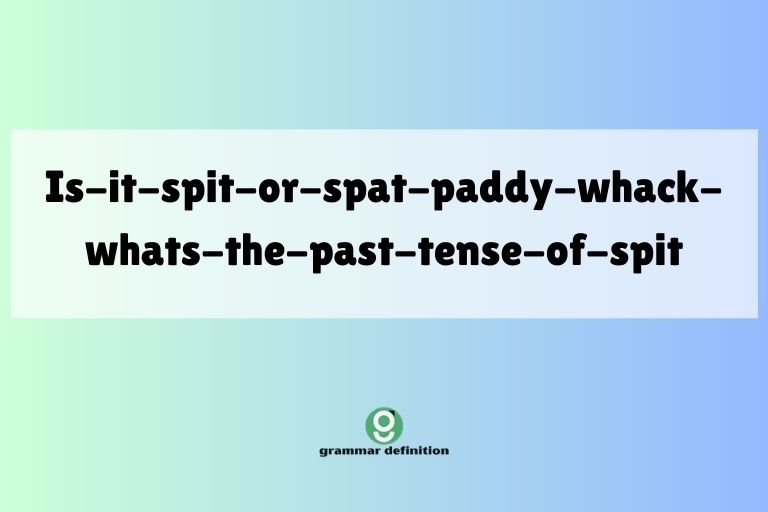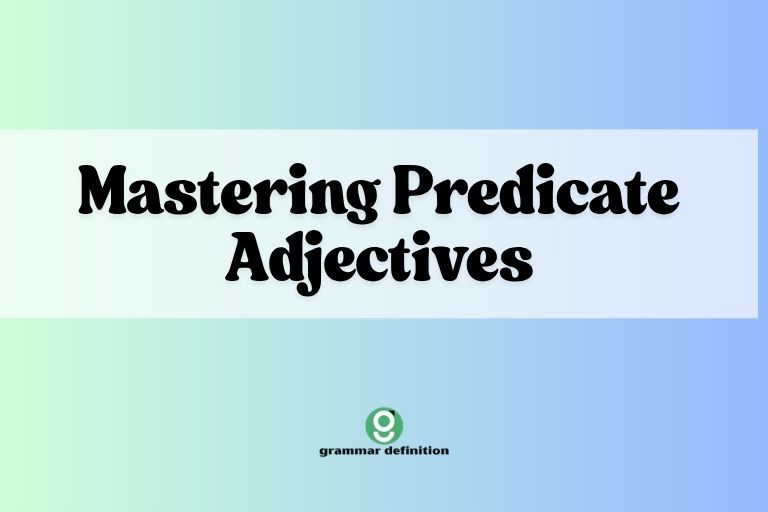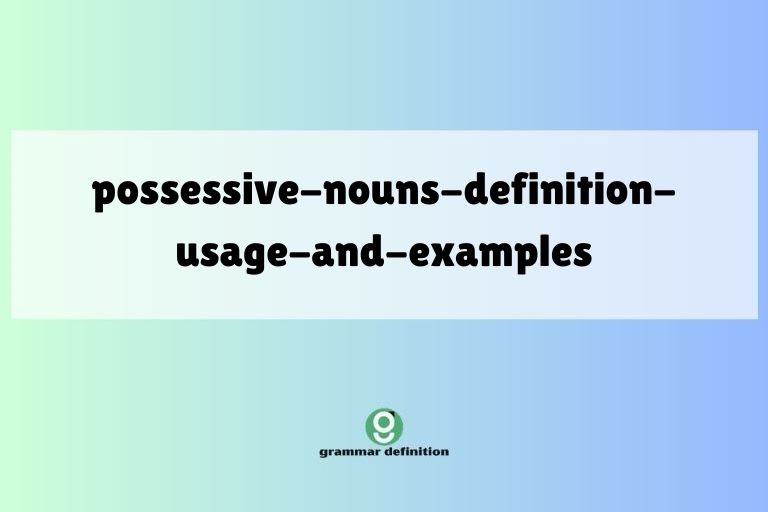Spit, Spat, or Spitten: Mastering the Past Tense of ‘Spit’

Understanding irregular verbs can be tricky for English language learners and native speakers alike. One such verb that often causes confusion is “spit.” Is the past tense “spit,” “spat,” or “spitten”?
This article will delve into the complexities of this verb, providing clear explanations, examples, and practice exercises to help you confidently use the correct form. Whether you’re an ESL student, a grammar enthusiast, or simply looking to improve your writing skills, this guide will provide a comprehensive understanding of the past tense of “spit.”
By the end of this article, you’ll not only know the correct past tense forms of “spit” but also understand the nuances and contexts in which each form is used. We’ll cover definitions, structural breakdowns, usage rules, common mistakes, and advanced topics to ensure a thorough grasp of this frequently misused verb.
Table of Contents
- Definition of ‘Spit’
- Structural Breakdown of the Verb ‘Spit’
- Types and Categories of Verb Tenses
- Examples of ‘Spit’ in Different Tenses
- Usage Rules for ‘Spit,’ ‘Spat,’ and ‘Spitten’
- Common Mistakes When Using ‘Spit’
- Practice Exercises
- Advanced Topics: Regional Variations and Formal Usage
- Frequently Asked Questions
- Conclusion
Definition of ‘Spit’
The verb “spit” refers to the act of ejecting saliva or other substances from the mouth. It can also be used metaphorically to express contempt or disdain.
Understanding its various forms and tenses is crucial for effective communication.
Classification: “Spit” is an irregular verb, meaning its past tense and past participle forms do not follow the standard “-ed” ending rule.
Function: “Spit” can function as both a transitive and an intransitive verb. As a transitive verb, it takes a direct object (e.g., “He spit out the gum”). As an intransitive verb, it does not take a direct object (e.g., “He spit on the ground”).
Contexts: The word “spit” can be used in a variety of contexts, ranging from everyday conversations to formal writing. It can describe a physical action, express emotion, or be used in figurative language.
Structural Breakdown of the Verb ‘Spit’
The principal parts of the verb “spit” are as follows:
- Base Form: spit
- Past Simple: spat / spit
- Past Participle: spit / spat / spitten (rare)
- Present Participle: spitting
The past simple form “spat” is more common in British English, while “spit” is frequently used in American English. “Spitten” is an archaic form and rarely used in modern English.
Here’s a breakdown of how the verb “spit” is conjugated in different tenses:
| Tense | Singular | Plural |
|---|---|---|
| Present Simple | I/you/we/they spit, he/she/it spits | We/you/they spit |
| Past Simple | I/you/he/she/it/we/they spat/spit | We/you/they spat/spit |
| Future Simple | I/you/he/she/it/we/they will spit | We/you/they will spit |
| Present Continuous | I am spitting, he/she/it is spitting, you/we/they are spitting | We/you/they are spitting |
| Past Continuous | I was spitting, he/she/it was spitting, you/we/they were spitting | We/you/they were spitting |
| Present Perfect | I/you/we/they have spit/spat, he/she/it has spit/spat | We/you/they have spit/spat |
| Past Perfect | I/you/he/she/it/we/they had spit/spat | We/you/they had spit/spat |
| Future Perfect | I/you/he/she/it/we/they will have spit/spat | We/you/they will have spit/spat |
Types and Categories of Verb Tenses
Understanding the different types of verb tenses is crucial for using “spit” correctly. Here’s a brief overview:
Simple Tenses
Simple tenses indicate a single action in the past, present, or future.
- Simple Present: Describes habitual actions or general truths. (e.g., He spits when he’s nervous.)
- Simple Past: Describes completed actions in the past. (e.g., She spat out the medicine.)
- Simple Future: Describes actions that will happen in the future. (e.g., They will spit if they don’t like the taste.)
Continuous Tenses
Continuous tenses describe actions that are in progress.
- Present Continuous: Describes actions happening now. (e.g., He is spitting on the sidewalk.)
- Past Continuous: Describes actions that were happening in the past. (e.g., She was spitting as she ran.)
- Future Continuous: Describes actions that will be happening in the future. (e.g., They will be spitting during the competition.)
Perfect Tenses
Perfect tenses describe actions that have been completed at a specific point in time.
- Present Perfect: Describes actions that started in the past and continue to the present or have a result in the present. (e.g., He has spit on the ground before.)
- Past Perfect: Describes actions that were completed before another action in the past. (e.g., She had spat out the food before I saw her.)
- Future Perfect: Describes actions that will be completed before a specific time in the future. (e.g., They will have spit out all the seeds by the end of the contest.)
Examples of ‘Spit’ in Different Tenses
To illustrate the usage of “spit” in different tenses, let’s look at some examples:
Examples in Simple Tenses
The following table provides examples of “spit” used in simple tenses. Note the use of both “spat” and “spit” in the past simple tense, reflecting regional variations.
| Tense | Example |
|---|---|
| Simple Present | He spits when he’s nervous. |
| Simple Present | She spits out the seeds of the watermelon. |
| Simple Present | They spit on the ground in disgust. |
| Simple Past | He spat out the gum. (British English) |
| Simple Past | He spit out the gum. (American English) |
| Simple Past | She spat the medicine back up. (British English) |
| Simple Past | She spit the medicine back up. (American English) |
| Simple Past | They spat on the ground in defiance. (British English) |
| Simple Past | They spit on the ground in defiance. (American English) |
| Simple Future | He will spit if he doesn’t like the taste. |
| Simple Future | She will spit the food out if it’s too spicy. |
| Simple Future | They will spit out the watermelon seeds. |
| Simple Future | I will spit if I accidentally bite my tongue. |
| Simple Future | You will spit if you eat something poisonous. |
| Simple Future | We will spit if the drink is too sour. |
| Simple Future | The baby will spit up the milk. |
| Simple Future | The cat will spit out the furball. |
| Simple Future | The machine will spit out the ticket. |
| Simple Future | The volcano will spit out lava and ash. |
Examples in Continuous Tenses
The following table provides examples of “spit” used in continuous tenses.
| Tense | Example |
|---|---|
| Present Continuous | He is spitting on the sidewalk. |
| Present Continuous | She is spitting out the water after her swim. |
| Present Continuous | They are spitting sunflower seeds. |
| Past Continuous | He was spitting while he was running. |
| Past Continuous | She was spitting blood after the accident. |
| Past Continuous | They were spitting out the bad-tasting gum. |
| Future Continuous | He will be spitting during the competition. |
| Future Continuous | She will be spitting out the food if she doesn’t like it. |
| Future Continuous | They will be spitting watermelon seeds all day. |
| Present Continuous | The actor is spitting out his lines with passion. |
| Present Continuous | The child is spitting up after eating too much candy. |
| Present Continuous | The dog is spitting out the bone. |
| Past Continuous | The fountain was spitting water into the air. |
| Past Continuous | The protesters were spitting slogans and chants. |
| Past Continuous | The printer was spitting out pages rapidly. |
| Future Continuous | The machine will be spitting out tickets all night. |
| Future Continuous | The volcano will be spitting lava for days. |
| Future Continuous | The athlete will be spitting and panting during the marathon. |
| Future Continuous | The robot will be spitting oil during the maintenance check. |
Examples in Perfect Tenses
The following table provides examples of “spit” used in perfect tenses, showing both “spit” and “spat” as past participles.
| Tense | Example |
|---|---|
| Present Perfect | He has spit on the ground before. |
| Present Perfect | He has spat on the ground before. |
| Present Perfect | She has spit out the medicine. |
| Present Perfect | She has spat out the medicine. |
| Present Perfect | They have spit sunflower seeds all over the park. |
| Present Perfect | They have spat sunflower seeds all over the park. |
| Past Perfect | He had spit before I could stop him. |
| Past Perfect | He had spat before I could stop him. |
| Past Perfect | She had spit out the food before I saw her. |
| Past Perfect | She had spat out the food before I saw her. |
| Past Perfect | They had spit on the flag in protest. |
| Past Perfect | They had spat on the flag in protest. |
| Future Perfect | He will have spit out all the gum by the end of the day. |
| Future Perfect | He will have spat out all the gum by the end of the day. |
| Future Perfect | She will have spit out the bad taste by then. |
| Future Perfect | She will have spat out the bad taste by then. |
| Future Perfect | They will have spit all the watermelon seeds by lunchtime. |
| Future Perfect | They will have spat all the watermelon seeds by lunchtime. |
| Future Perfect | By the time the show ends, the actor will have spit out his lines with intensity. |
| Future Perfect | By the time the show ends, the actor will have spat out his lines with intensity. |
Usage Rules for ‘Spit,’ ‘Spat,’ and ‘Spitten’
The primary usage rule is to understand the regional differences and stick to one form for consistency. Here’s a detailed breakdown:
- ‘Spit’ as Past Simple: Common in American English. Acceptable and widely understood.
- ‘Spat’ as Past Simple: More common in British English. Also acceptable in American English, though it might sound slightly formal or archaic.
- ‘Spit’ as Past Participle: Acceptable in both American and British English, particularly when used with auxiliary verbs like “have” or “had.”
- ‘Spat’ as Past Participle: Also acceptable as a past participle, though less common than “spit” in American English.
- ‘Spitten’ as Past Participle: Very rare and archaic. Avoid using it in modern English unless you are aiming for a specific historical or literary effect.
Consistency: Regardless of which form you choose (“spit” or “spat”), it’s essential to maintain consistency throughout your writing. Mixing forms can confuse readers.
Formal vs. Informal: “Spat” might be perceived as slightly more formal than “spit,” but both are generally acceptable in both formal and informal contexts.
Common Mistakes When Using ‘Spit’
Here are some common mistakes to avoid when using the verb “spit”:
| Incorrect | Correct | Explanation |
|---|---|---|
| He spitted on the ground. | He spat/spit on the ground. | “Spitted” is not a standard form of the past tense of “spit.” |
| She has spitted out the medicine. | She has spit/spat out the medicine. | “Spitted” is not a correct past participle. |
| I will have spit/spatted by noon. | I will have spit/spat by noon. | “Spatted” is not a correct past participle. |
| They are spiting on the street. | They are spitting on the street. | The correct present participle is “spitting,” with a double ‘t’. |
| He spit out the gum yesterday. | He spat/spit out the gum yesterday. | While “spit” can be used as the past tense, “spat” is also correct, especially in British English. |
| She spitted the apple seed. | She spat/spit the apple seed. | “Spitted” is not a valid past tense form of “spit.” |
| He had spitten on the floor. | He had spit/spat on the floor. | “Spitten” is an archaic past participle form that is rarely used today. |
| I am going to spit out the bone. | I am going to spit out the bone. | This sentence is already correct. |
| They will be spiting sunflower seeds. | They will be spitting sunflower seeds. | The correct present participle is “spitting,” with a double ‘t’. |
| She has spit out the medicine | She has spit out the medicine. | This sentence is already correct. |
Practice Exercises
Test your understanding with these practice exercises. Fill in the blanks with the correct form of “spit.”
Exercise 1: Simple Past Tense
| Question | Answer |
|---|---|
| 1. He ______ out the bad-tasting medicine. | spat/spit |
| 2. She ______ the watermelon seeds into the garden. | spat/spit |
| 3. They ______ on the ground in disgust. | spat/spit |
| 4. I ______ my gum out before entering the building. | spat/spit |
| 5. You ______ out the truth eventually. | spat/spit |
| 6. We ______ on our hands before starting the fire. | spat/spit |
| 7. The cat ______ out a furball. | spat/spit |
| 8. The baby ______ up the milk. | spat/spit |
| 9. The machine ______ out the ticket. | spat/spit |
| 10. The volcano ______ out lava and ash. | spat/spit |
Exercise 2: Past Participle
| Question | Answer |
|---|---|
| 1. He had ______ on the ground before I noticed. | spit/spat |
| 2. She has ______ out the poison. | spit/spat |
| 3. They have ______ sunflower seeds all over the place. | spit/spat |
| 4. I have never ______ so hard in my life. | spit/spat |
| 5. You have ______ out the truth to me. | spit/spat |
| 6. We have ______ on the floor before. | spit/spat |
| 7. The cat has ______ up a furball again. | spit/spat |
| 8. The baby has ______ up all of the milk. | spit/spat |
| 9. The machine had ______ out the money before I got there. | spit/spat |
| 10. The volcano has ______ out lava all night. | spit/spat |
Exercise 3: Mixed Tenses
| Question | Answer |
|---|---|
| 1. He usually ______ when he’s nervous, but yesterday he ______. | spits, spat/spit |
| 2. She is ______ out the medicine because she had ______ it before. | spitting, spat/spit |
| 3. They will be ______ sunflower seeds if they haven’t ______ them all already. | spitting, spat/spit |
| 4. I ______ out my gum and then I ______ on the ground. | spit/spat, spit/spat |
| 5. You must ______ out the water before you ______ it. | spit, spat/spit |
| 6. We will ______ on our hands if we get burned from the fire. | spit |
| 7. The cat ______ up the hairball and then she ______ on the floor. | spit, spat/spit |
| 8. The baby will ______ all of the milk if we continue to feed it. | spit |
| 9. The machine ______ out more tickets if we put more money in it. | spits |
| 10. The volcano ______ out lava when it ______ up. | spits, spat/spit |
Advanced Topics: Regional Variations and Formal Usage
For advanced learners, understanding the nuances of regional variations and formal usage can further refine their understanding of the verb “spit.”
- Regional Variations: As mentioned earlier, “spat” is more common in British English, while “spit” is more prevalent in American English. Being aware of these differences can help you better understand and communicate with speakers from different regions.
- Formal Usage: In formal writing, it’s generally advisable to use “spat” as the past tense to maintain a sense of formality. However, “spit” is also acceptable, especially in American English.
- Figurative Language: The verb “spit” can be used metaphorically to express strong emotions or contempt. For example, “He spat out the words with venom” conveys a sense of anger and hatred.
Frequently Asked Questions
- Is “spitten” ever correct?
While “spitten” is a past participle of “spit,” it is considered archaic and is rarely used in modern English. It might appear in older literature, but it’s best to avoid using it in contemporary writing or speech.
- Is it better to use “spit” or “spat” in American English?
In American English, “spit” is more commonly used as the past tense and past participle. While “spat” is understood, it might sound slightly formal or less natural.
- Is it better to use “spit” or “spat” in British English?
In British English, “spat” is more commonly used as the past tense and past participle. “Spit” is also understood but less frequently used.
- Can “spit” be used as a noun?
Yes, “spit” can also be used as a noun, referring to saliva or the act of spitting. For example, “He wiped the spit from his chin.”
- What is the present participle of “spit”?
The present participle of “spit” is “spitting.” Remember to double the ‘t’ before adding “-ing.”
- How do I avoid making mistakes with irregular verbs like “spit”?
The best way to avoid mistakes is to practice regularly and familiarize yourself with the different forms of the verb. Pay attention to the context and choose the appropriate tense and form.
- Is there a difference in meaning between “spit” and “spat”?
No, there is no difference in meaning between “spit” and “spat.” They both refer to the same action of ejecting saliva or other substances from the mouth. The difference lies in regional usage and preference.
- How can I remember the past tense forms of “spit”?
One helpful way to remember the past tense forms is to create mnemonic devices or use the word in sentences frequently. For example, “I spat out the bad taste” or “He spit on the ground.” Practice and repetition will help solidify your understanding.
Conclusion
Mastering the past tense of “spit” requires understanding its irregular nature and regional variations. While both “spit” and “spat” are acceptable, “spat” is more common in British English, and “spit” is more prevalent in American English.
The archaic form “spitten” should generally be avoided in modern usage. By studying the definitions, structural breakdowns, examples, and practice exercises provided in this article, you can confidently use the correct form of “spit” in your writing and speech.
Remember to practice regularly and pay attention to the context in which you are using the verb. Consistency is key, so choose a form and stick with it.
With continued effort, you’ll be able to navigate the complexities of “spit” and other irregular verbs with ease. Good luck, and happy learning!






